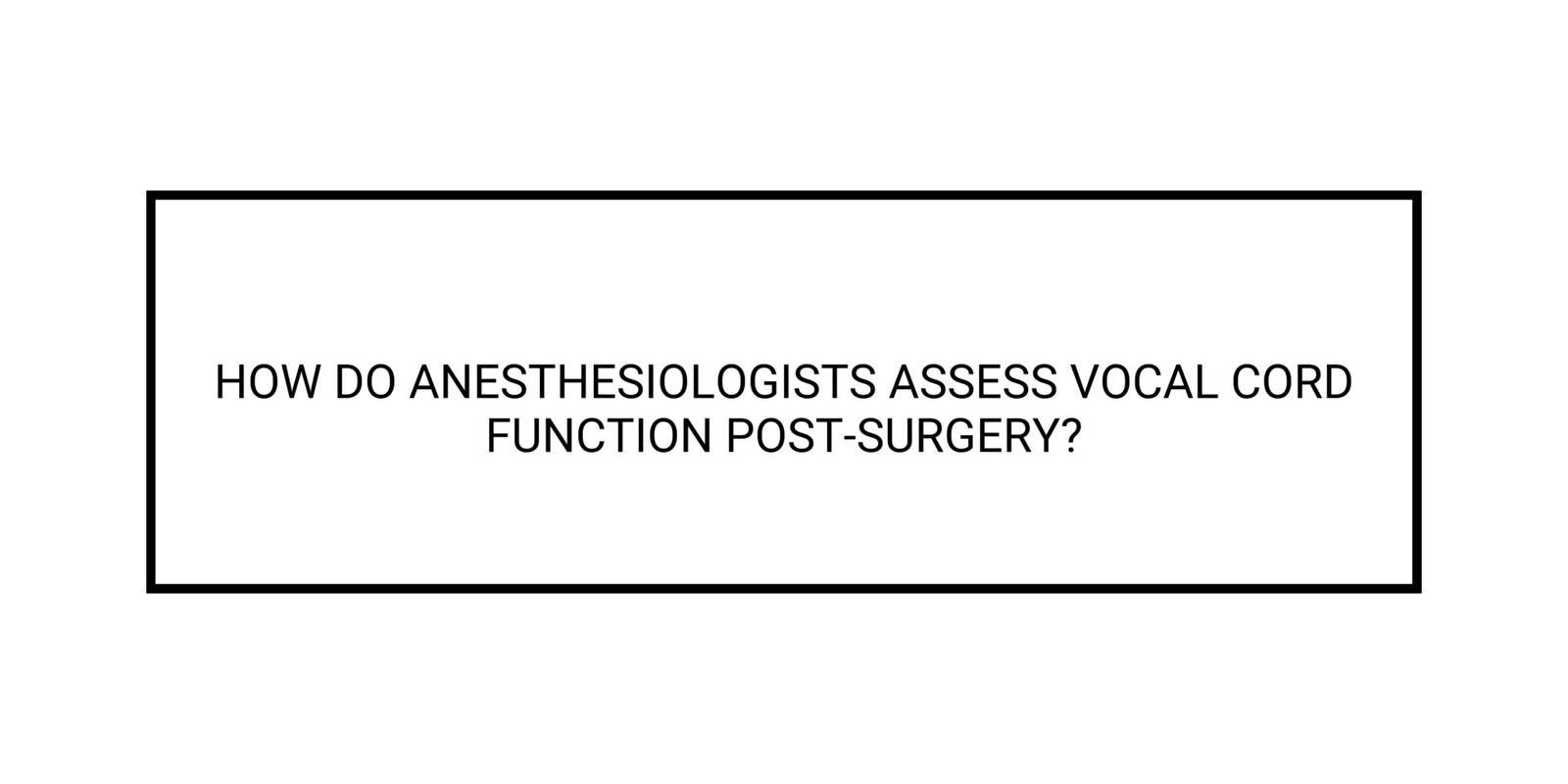Anesthesiologists often encounter the challenge of assessing vocal cord function post-surgery, especially after procedures that involve intubation or head and neck surgeries. Here’s an in-depth look at common assessment techniques and their significance.
1. Clinical Observation and Patient Interviews
Anesthesiologists typically begin with a fundamental assessment by observing the patient’s voice and conducting interviews. They listen for any hoarseness, changes in pitch, or difficulty speaking, which can indicate vocal cord dysfunction. This simple, non-invasive approach can be an essential first step in identifying potential issues.
Reference:
D. McIvor, C. Burrows, “Postoperative Hoarseness and Dysphonia,” Otolaryngologic Clinics of North America, 2015.
2. Maximum Phonation Time (MPT)
MPT is an easy-to-administer test where the patient is asked to sustain a vowel sound, usually “aaaah,” for as long as possible. A reduced MPT may be indicative of impaired vocal cord mobility or glottic insufficiency. This technique helps identify early signs of vocal cord dysfunction.
Reference:
S. Hirano, “Clinical Assessment of Voice,” The Laryngoscope, 2004, pp. 165–168.
3. GRBAS Scale
The GRBAS scale evaluates the perceptual voice quality and is based on five parameters: Grade, Roughness, Breathiness, Asthenia, and Strain. Each characteristic is rated on a scale from 0 to 3, providing a structured and systematic approach to voice assessment.
Reference:
Hirano, M. “Perceptual Assessment of Voice: GRBAS Scale,” Journal of Voice Disorders, 1994, pp. 1–7.
4. Voice Handicap Index (VHI)
The Voice Handicap Index is a self-reported questionnaire with 30 questions designed to measure the patient’s perception of how vocal issues affect their daily activities and quality of life. It’s an invaluable tool for understanding the patient’s experience and guiding further evaluations.
Reference:
Jacobson, B.H. et al., “The Voice Handicap Index (VHI): Development and Validation,” American Journal of Speech-Language Pathology, 1997.
5. Voice-Related Quality of Life (V-RQOL) Questionnaire
The V-RQOL questionnaire is another validated self-assessment tool that evaluates the impact of vocal disorders on a patient’s quality of life. It provides insights into how vocal issues affect physical, emotional, and social aspects of life.
Reference:
Hogikyan, N.D., Sethuraman, G., “Validation of an Instrument to Measure Voice-Related Quality of Life (V-RQOL),” Journal of Voice, 1999.
6. Acoustic Analysis
Acoustic analysis involves recording the patient’s voice using specialized software to assess parameters such as jitter, shimmer, and the noise-to-harmonic ratio. These measurements provide objective data on voice quality, allowing for precise identification of vocal cord dysfunction.
Reference:
Titze, I.R., “Principles of Voice Production,” National Center for Voice and Speech, 1994, pp. 240–250.
7. Laryngoscopy
Laryngoscopy is considered the gold standard for assessing vocal cord injuries. While not typically performed by anesthesiologists, this procedure involves direct visualization of the vocal cords and is crucial for diagnosing structural abnormalities.
Reference:
Benjamin, B., “Laryngoscopic Evaluation of Vocal Cord Pathologies,” Otolaryngologic Clinics of North America, 2003.
8. Transcutaneous Laryngeal Ultrasonography (TLUSG)
TLUSG is an emerging non-invasive technique for assessing vocal cord movement. It offers real-time visualization without requiring an invasive procedure, making it a promising alternative to flexible fiberoptic laryngoscopy.
Reference:
G. Shama Rao et al., “Assessment of Vocal Cord Function Using Ultrasound,” Indian Journal of Anaesthesia, 2018.
9. Fiber Bronchoscopy
In cases where there are concerns about both vocal cord function and lower airway issues, fiber bronchoscopy can be used. This procedure allows for a comprehensive assessment of the airway, including vocal cord movement.
Reference:
Kost, K.M., “Flexible Bronchoscopy in Assessing Airway Function,” Annals of Otolaryngology, 1990.
10. Indirect Laryngoscopy
Although less commonly used in the immediate post-operative period, indirect laryngoscopy involves visualizing the vocal cords with a mirror. It remains a valuable technique in settings where more advanced equipment is unavailable.
Reference:
Levy, L., “Indirect Laryngoscopy: Techniques and Applications,” Archives of Otolaryngology, 1975.
Conclusion
Anesthesiologists are pivotal in detecting potential vocal cord issues post-surgery. Employing a combination of these assessment techniques allows for early identification of injuries, ensuring timely intervention. When vocal cord dysfunction is suspected, a referral to an otolaryngologist for further evaluation and management is recommended.
Full References
- D. McIvor, C. Burrows, “Postoperative Hoarseness and Dysphonia,” Otolaryngologic Clinics of North America, 2015.
- S. Hirano, “Clinical Assessment of Voice,” The Laryngoscope, 2004, pp. 165–168.
- Hirano, M. “Perceptual Assessment of Voice: GRBAS Scale,” Journal of Voice Disorders, 1994, pp. 1–7.
- Jacobson, B.H. et al., “The Voice Handicap Index (VHI): Development and Validation,” American Journal of Speech-Language Pathology, 1997.
- Hogikyan, N.D., Sethuraman, G., “Validation of an Instrument to Measure Voice-Related Quality of Life (V-RQOL),” Journal of Voice, 1999.
- Titze, I.R., “Principles of Voice Production,” National Center for Voice and Speech, 1994, pp. 240–250.
- Benjamin, B., “Laryngoscopic Evaluation of Vocal Cord Pathologies,” Otolaryngologic Clinics of North America, 2003.
- G. Shama Rao et al., “Assessment of Vocal Cord Function Using Ultrasound,” Indian Journal of Anaesthesia, 2018.
- Kost, K.M., “Flexible Bronchoscopy in Assessing Airway Function,” Annals of Otolaryngology, 1990.
- Levy, L., “Indirect Laryngoscopy: Techniques and Applications,” Archives of Otolaryngology, 1975.


